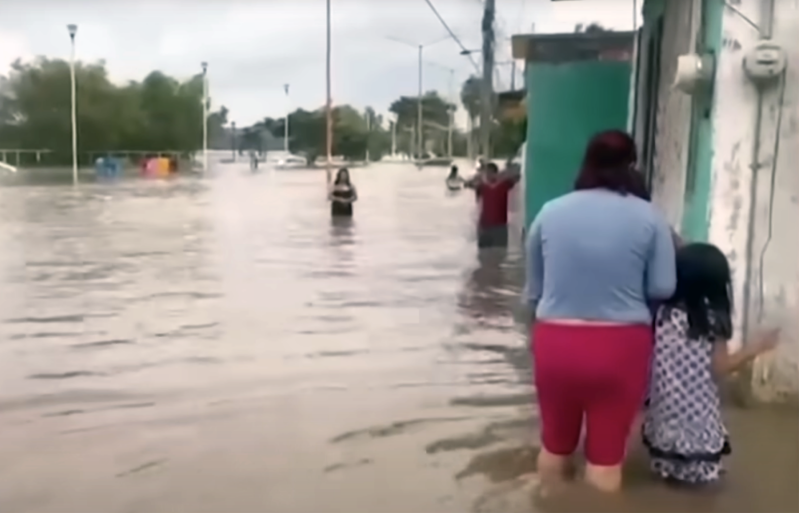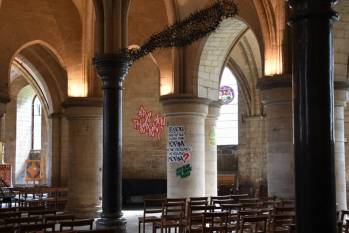
Torrential rains and massive flooding have killed at least 64 people and left dozens missing across central and eastern Mexico, prompting churches and faith-based groups to mobilize nationwide to help survivors as authorities race to reach isolated communities.
Triggered by the remnants of Tropical Storms Raymond and Priscilla, the floods have caused widespread destruction in Hidalgo, Veracruz, Querétaro, Puebla, and San Luis Potosí, where overflowing rivers, landslides, and collapsed bridges have cut off towns and villages. Thousands of families have lost their homes and belongings, and power outages have left more than 40,000 people in the dark.
President Claudia Sheinbaum said on Monday (Oct. 13) that her administration estimates about 100,000 homes were affected by flooding and landslides. Dozens of communities remain isolated, she said, and food and water must be flown in to reach those trapped by collapsed bridges and damaged roads, according to reporting by The New York Times.
“There were no scientific or meteorological conditions that could have indicated to us that the rainfall would be of this magnitude,” Sheinbaum told reporters, explaining that government attention had been focused on the Pacific, where the two storms formed off western Mexico. Instead, it was the central and eastern states that endured the worst destruction, with some areas receiving as much as 20 inches of rain in just four days, government figures show.
Churches turn sanctuaries into aid centers
Since last Friday, floodwaters have submerged homes and streets under water and mud, leaving entire communities devastated. Christian denominations and organizations have quickly mobilized to support those affected, converting churches and auditoriums into emergency collection centers.
“We have nothing left. The water came in very fast; we didn’t know what to do to stop it, and we were very frightened,” said Julia, a resident of Tianguistengo, Hidalgo.
Churches across the affected regions have requested donations of canned food, bottled water, clothing, cleaning supplies, and hygiene products to deliver to victims. Pastors have organized their congregations to assist in gathering and distributing aid to those in need.
“We have not been able to contact our brothers and sisters; there are several landslides, and we know that the water took away the bridges,” said Pastor Óscar Moedano, minister of the Aliento de Vida congregation. “We have helped during other floods, but this situation is complicated. We had never seen a tragedy of this magnitude in Hidalgo.”
Moedano told Diario Cristiano, Christian Daily International's Spanish edition, that the tragedy defies understanding but that church members are determined to bring help to affected communities. “We are going to gather what is necessary for our brothers and sisters,” he said.
Entire towns submerged
Photos circulating on social media show extensive damage in Poza Rica, Veracruz, one of the hardest-hit cities in what has become one of Mexico’s most severe natural disasters of 2025. The overflowing Cazones River inundated neighborhoods and forced residents to climb onto rooftops to survive as the water rose rapidly, sweeping away cars and flooding entire streets.
Local residents estimated that the river reached historic levels, surpassing seven meters in height. Videos show water-damaged furniture and thick mud inside homes and churches.
“We tried to rescue as much as we could, but the water flooded our church and our homes. It is very sad what we are living through,” said a woman cleaning the floor of her congregation in Poza Rica.
Victims and growing frustration
According to the National Civil Protection Coordination, at least 64 people have died, 65 remain missing, and tens of thousands have been displaced.
In Pachuca, capital of Hidalgo state, residents gathered in Plaza Juárez to demand a faster government response. Protesters said their relatives are stranded without food or water and that many areas remain unreachable by land.
“We want the government or the military to help us with helicopters because our relatives are completely isolated. They have no food, and there is no help for them,” said Jennifer Reyes.
Faced with delays in official assistance, several neighbors organized voluntary collections to hire private helicopters to deliver food and water to relatives in remote areas.
Emergency response and public discontent
Since Sunday, displaced families have begun cleaning and removing debris from flooded homes, rural villages, and urban neighborhoods.
Following criticism over the government’s pace of response, President Sheinbaum deployed federal, state, and local authorities to coordinate medical aid, search for missing persons, and distribute supplies. Three days after the disaster, the government activated the DN-III-E Emergency Plan, sending army personnel and helicopters to deliver assistance.
However, the delayed implementation has drawn frustration from residents, some of whom accuse officials of reacting too slowly. In several towns, citizens have demanded a stronger government presence and more direct assistance.
In the absence of immediate state relief, Christian groups have played an important role in the humanitarian response. Across Hidalgo, Veracruz, and neighboring states, congregations are gathering donations, cooking meals, and providing shelter to displaced families.





